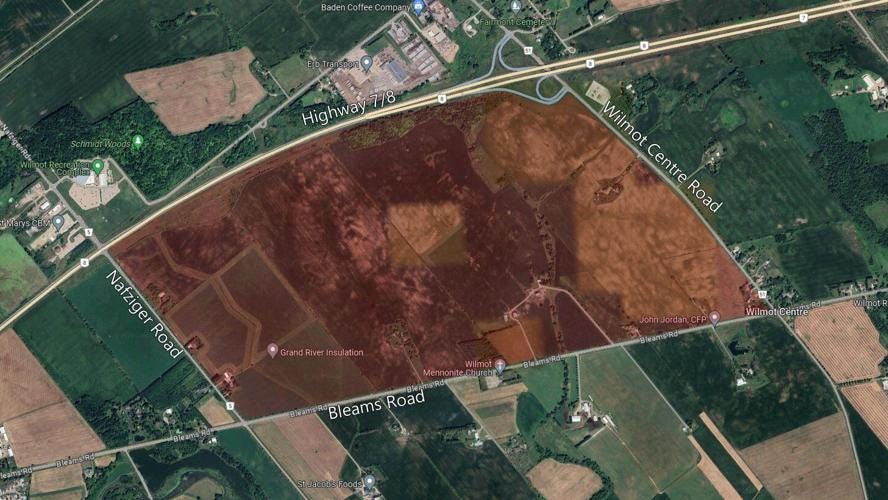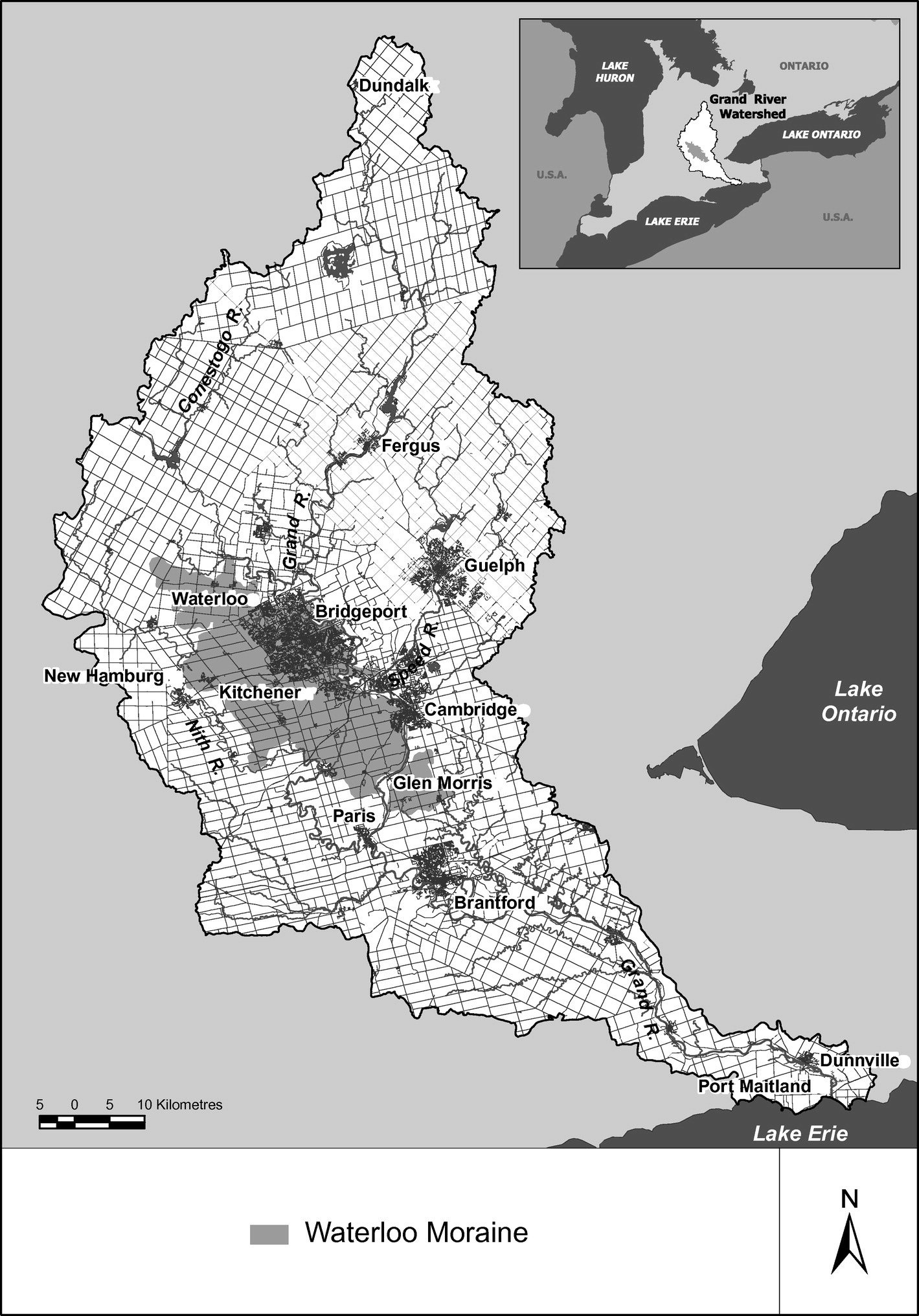Hush Hush in Wilmot (pt. 1)
Farmland, a 'mega-site', expropriation threats - what's going on in Wilmot?
The Region of Waterloo, through Canacre (a private-sector consultant specializing in industrial land assembly that was retained by the region), attempted to purchase farmland in Wilmot earlier this year (for $35,000 an acre). The offers (with the threat of expropriation) not only caught these property owners off guard, but also the larger community, as to date, there has been no public process indicating interest in these lands as a ‘mega site’ for employment lands. So, what exactly is happening here? Well, a lot, actually so this is the first of several posts looking at what’s happening with the ‘Wilmot Lands’.
(This is part one of a series. Read part two here.)
Where are we talking about exactly?
770 acres of land bordered by Bleams Rd, Nafziger Rd, Highway 7/8 and Wilmot Centre Road. The properties range from 25 acres to 180 acres in lot size.

What started all of this?
In early March, several property owners were approached by Canacre, on behalf of the Region of Waterloo. Canacre offered property owners $35,000/acre for their land. However, Stewart Snyder, a dairy farmer on Nafziger Road, said the “Canacre rep was clear — those who refuse to sell will be expropriated.”
Snyder and several of his neighbours were surprised by the offers and frustrated that they couldn’t get any answers from the Region about what was happening. They are “baffled that millions of taxpayer dollars will be spent on creating a big, single parcel of land but nobody will tell the property owners what is going on.” Those seeking additional details have been met largely with silence from elected officials. In fact, according to this WR Record article, “local councillors have received specific instructions — do not talk about the land assembly.” Wilmot Councillor, Steven Martin, stated, “I can refer you to the region. That’s all I can say at this point. I am sorry about that, at this point there is not much I can say. I apologize.” People with questions have been told to contact Matthew Chandy, the Region’s Head of Economic Development. However, he also doesn’t seem to be responding to inquiries.
Cambridge Mayor Jan Liggett notes that both upper and lower tier (i.e. Regional and city/township) councillors are legislatively bound by confidentiality when they take their oath of office. In an email outlined in this WR Record article, she stated, “As you know, any closed-door item has to remain closed no matter what the item is and whether one agrees with a majority decision or not.” In that same article, Waterloo Mayor Dorothy McCabe directed questions on the land assembly to Wilmot Mayor Natasha Salonen and Regional Chair Redman, who are referred to as the “designated spokespeople” on the issue.
The farmers hired a lawyer, launched a website and collected thousands of signatures on a petition protesting the township and region’s plans to expropriate them.
What should we know about the Wilmot Lands?
The Waterloo Moraine covers a large portion of Kitchener, Waterloo, and Wilmot. “The unique location of the Waterloo Moraine, straddling the Carolinian life zone and the Great Lakes forest zone, is ecologically significant. A number of species reach their northern or southern range limits here.”
This area is home to some of the most productive farmland in Ontario. It is also home to two creeks flowing through it that empty into the Nith River. Local farmer Stewart Snyder notes that the area includes “two wellhead protection areas that provide drinking water for the region, found on its eastern and northern borders.”
Waterloo Region is distinctive in that it is the largest urban municipality in Ontario to rely almost exclusively on groundwater supplies for its drinking water. “Approximately three quarters of all the region’s drinking-water comes from the over one hundred municipal wells, many of which tap into rich aquifers sustained by the Waterloo Moraine.”

The Waterloo Moraine contains Regional Recharge Areas which “play a crucial role in providing clean water to the Region’s municipal drinking-water supply system.” These areas “allow for the natural infiltration of large quantities of rainfall, snowmelt, and in some cases, seepage from creeks and streams into a series of deep and shallow aquifers.”
It’s worth noting that the Provincial Policy Statement directs the Region of Waterloo “to protect the quality and quantity of drinking water resources in the region, and to limit development and site alteration that could adversely affect drinking-water supplies drawn from both the Grand River and groundwater resources.”
Learn about aquifers, regional recharge areas, and more from the Grand River Conservation Authority.
Who is behind this?
While it’s not entirely clear who is driving this push, there are a few ‘prime suspects’ that may be involved, in addition to the Region of Waterloo.
In his recent column, Mike Farwell reminds readers that Toyota has expressed a desire to build an EV facility near its Cambridge plant. He states, “earlier this year, our local chambers of commerce said that making sure Toyota continues expanding here should be a huge priority for this region.”
Terry Pender, with the WR Record, shares that some local developers had made offers on six Wilmot Township farms prior to the Region’s offer. Pender learned, “Through a numbered company, Vive Development offered $58,000 an acre for farms along Wilmot Centre, Bleams and Nafziger roads. The offers were made in early January, and none were accepted by the farmers.” In that same article, Stephen Litt says that “agricultural land sells for $35,000 to $60,000 an acre and shovel-ready industrial land sells for $2 million to $3 million an acre.” If that’s accurate, it seems like the Region’s offer of $35,000/acre is on the low end of that spectrum.
It seems likely that the province is involved in this process as well. In her recent column, Luisa D’Amato suspects that Doug Ford is behind this latest plan, writing “We already know he is impatient to build homes and workplaces, and he doesn’t care whether they are built on irreplaceable farmland, protected natural areas, or not.” Although, yesterday, Ford denied that there was a specific business lined up to take on these employment lands, saying “We have no one in the back area waiting to jump in there.”
Of course, Doug Ford’s Get It Done Act may soon open up much more land to developers (More on this Act in a future post). I spoke with NDP MPP (Waterloo) Catherine Fife who asks where the funds for this land assembly are coming from because there wasn’t any funding last year for such projects. She suspects that not only is the province involved but that they may even be funding it.
Fife says this approach is “this government’s modus operandi. They had to walk back the Greenbelt development. They had to walk back boundary expansions. Yet there are still conversations happening out of view about ‘What land do you want?’ It seems this government is still offering land access through back doorways.”
Can the Region expropriate these lands?
According to this column, if “these property owners don’t quickly agree to sell, they’re being threatened with expropriation.” One local dairy farmer, Adam van Bergeijk, says “These last couple of weeks have been devastating for us. There’s nothing we can do. It’s kind of like a knife on your throat.”
Expropriation is “the taking of land without consent of the owner by an Expropriating Authority in the exercise of its statutory powers.” An expropriation may take all of a property, part of a property, or it may take only a partial interest in a property, for example, an easement or subterranean rights. So, can the Region simply expropriate these lands, without any sort of public process?
This article says that there is no requirement for disclosure under province’s Expropriations Act. So, the short answer is ‘yes’ the Region can do this. While I think it’s likely necessary for municipalities to have the right to expropriate lands, it should use such powers judiciously and with the larger ‘public good’ as the primary focus. So, for me, that means that expropriating say, a parking lot in order to build a hospital or transit infrastructure seems appropriate, whereas expropriating quality farmland to largely benefit private industry does not. MPP Catherine Fife says, “If the region is actively trying to expropriate land for private interests, it’s a huge concern, especially given its commitment to the integrity of the countryside line, which establishes planning protections for environmentally sensitive areas.”
Fife also states, “The process of expropriating prime farmland in Wilmot Township has lacked transparency, with no public consultation or information in response to concerns about how rezoning and development will affect our water resources.”
Farmers were given just days to decide whether to accept the Region’s offer to purchase lands for $35,000/acre or risk expropriation. With a goal of having lands in place by this August, the region says “timelines are tight so it may expropriate the properties and negotiate compensation later.” However, Liviu Cananau, a Toronto-based lawyer who specializes in municipal law, land acquisition and expropriation thinks that timeline is unlikely.
Calling the timeline ‘optimistic’, Cananau says the expropriation process includes a ‘Hearing of Necessity’. (Learn more about Hearings of Necessity, here.) He says, “assuming the Hearing of Necessity has not been waived by the province, then that will take some time, that will take several months to play out.”
Whether that timeline is realistic or not, MPP Fife introduced a petition urging the province to “immediately pause all plans to expropriate and rezone lands in Wilmot Township, to respect the regional planning processes, and to prioritize environmentally conscious, sustainable development in Waterloo Region.”
Next week, we will continue our look at the Wilmot Lands and some policy considerations such as the Regional Official Plan, the Countryside Line, Employment Lands, and protecting our farmland.
I want to thank all of the local journalists working hard on this story. Much of their work has provided the basis of my understanding on what’s happening with these lands in Wilmot. A special thanks to Terry Pender who has put in countless hours on following this developing story. If you are able, please consider supporting our local journalists.





Thank you very much for raising awareness on this issue.
Thanks for this (and ongoing) summary of what is happening. Very appreciated!